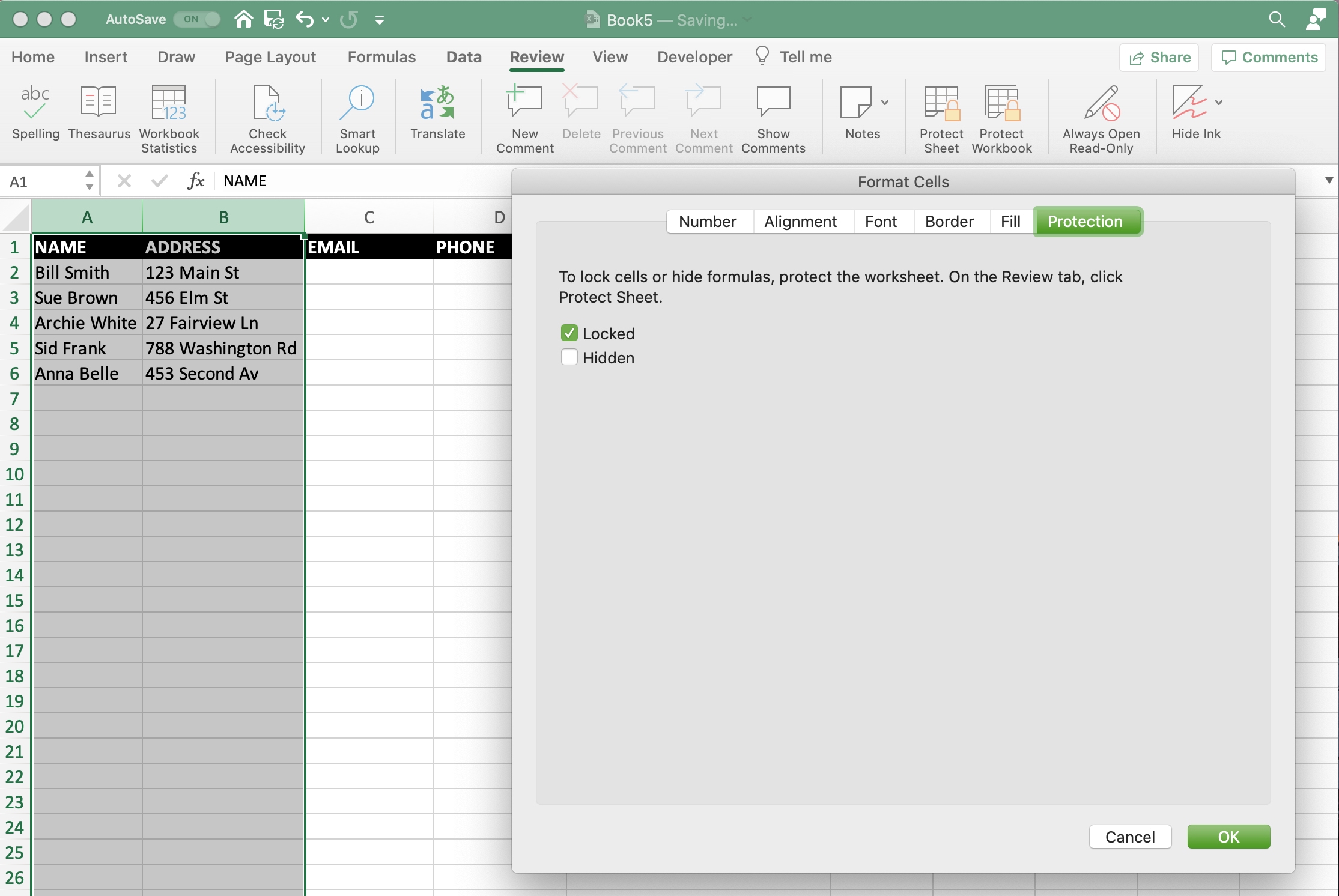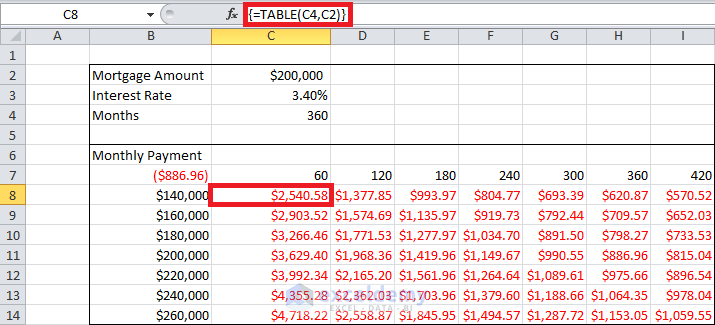
- EXCEL MAC FORMULA FOR SENSITIVITY TABLE FOR FREE
- EXCEL MAC FORMULA FOR SENSITIVITY TABLE FOR MAC
- EXCEL MAC FORMULA FOR SENSITIVITY TABLE UPDATE
- EXCEL MAC FORMULA FOR SENSITIVITY TABLE SOFTWARE
- EXCEL MAC FORMULA FOR SENSITIVITY TABLE LICENSE
Control charts - X-bar, R-chart, S-chart, IMR-chart, P-chart, C-chart, U-chart, CUSUM-chart.Quantile-quantile Q-Q plots for different distributions.Bland-Altman plot with multiple measurements per subject.
 Sampling (random, periodic, conditional). Report includes: AUC (with confidence intervals), curve coordinates, performance indicators - sensitivity and specificity (with confidence intervals), accuracy, positive and negative predictive values, Youden's J (Youden's index), Precision-Recall plot. Receiver operating characteristic curves analysis (ROC analysis).ĪUC methods - DeLong's, Hanley and McNeil's. LD values (LD50/ED50 and others), cumulative coefficient calculation. Kaplan-Meier (log rank test, hazard ratios). Unit root tests - Dickey–Fuller, Augmented Dickey–Fuller (ADF test), Phillips–Perron (PP test), Kwiatkowski–Phillips–Schmidt–Shin (KPSS test). Tests for heteroscedasticity: Breusch–Pagan test (BPG), Harvey test, Glejser test, Engle's ARCH test (Lagrange multiplier) and White test. Stepwise (forward and backward) regression. Weighted least squares (WLS) regression. Multivariate linear regression (residuals analysis, collinearity diagnostics, confidence and prediction bands). Wilcoxon Matched Pairs Test, Sign Test, Friedman ANOVA, Kendall's W (coefficient of concordance). Mann-Whitney U Test, Kolmogorov-Smirnov test, Wald-Wolfowitz Runs Test, Rosenbaum Criterion. Rank correlations (Kendall Tau, Spearman R, Gamma, Fechner). 2x2 tables analysis (Chi-square, Yates Chi-square, Exact Fisher Test, etc.). Within subjects ANOVA and mixed models. Post-hoc comparisons - Bonferroni, Tukey-Kramer, Tukey B, Tukey HSD, Neuman-Keuls, Dunnett. Type the cell reference for the input cell in the Column input cell box. Do one of the following: If the data table is.
Sampling (random, periodic, conditional). Report includes: AUC (with confidence intervals), curve coordinates, performance indicators - sensitivity and specificity (with confidence intervals), accuracy, positive and negative predictive values, Youden's J (Youden's index), Precision-Recall plot. Receiver operating characteristic curves analysis (ROC analysis).ĪUC methods - DeLong's, Hanley and McNeil's. LD values (LD50/ED50 and others), cumulative coefficient calculation. Kaplan-Meier (log rank test, hazard ratios). Unit root tests - Dickey–Fuller, Augmented Dickey–Fuller (ADF test), Phillips–Perron (PP test), Kwiatkowski–Phillips–Schmidt–Shin (KPSS test). Tests for heteroscedasticity: Breusch–Pagan test (BPG), Harvey test, Glejser test, Engle's ARCH test (Lagrange multiplier) and White test. Stepwise (forward and backward) regression. Weighted least squares (WLS) regression. Multivariate linear regression (residuals analysis, collinearity diagnostics, confidence and prediction bands). Wilcoxon Matched Pairs Test, Sign Test, Friedman ANOVA, Kendall's W (coefficient of concordance). Mann-Whitney U Test, Kolmogorov-Smirnov test, Wald-Wolfowitz Runs Test, Rosenbaum Criterion. Rank correlations (Kendall Tau, Spearman R, Gamma, Fechner). 2x2 tables analysis (Chi-square, Yates Chi-square, Exact Fisher Test, etc.). Within subjects ANOVA and mixed models. Post-hoc comparisons - Bonferroni, Tukey-Kramer, Tukey B, Tukey HSD, Neuman-Keuls, Dunnett. Type the cell reference for the input cell in the Column input cell box. Do one of the following: If the data table is. In Excel for Mac 2011: On the Data tab, under Analysis, click What-If, and then click Data Table.
One-way and two-way ANOVA (with and without replications). In Excel 2016 for Mac: Click Data > What-if Analysis > Data Table. Multiple definitions for computing quantile statistics. Frequency tables analysis (for discrete and continuous variables). Normality tests (Jarque-Bera, Shapiro-Wilk, Shapiro-Francia, Cramer-von Mises, Anderson-Darling, Kolmogorov-Smirnov, D'Agostino's tests). Migration guide for users switching from Analysis ToolPak. Options to emulate Excel Analysis ToolPak results and. Permanent license and free major upgrades during the maintenance period. Standalone spreadsheet with Excel (XLS and XLSX), OpenOffice/LibreOffce Calc (ODS) and text documents support. This free application demonstrates qualities typically only available in costly specialized suites – consistency and accuracy of results, reliability, plenty of data analysis models and tools, various data types, graphs, charts and much, much more. No matter if you are an experienced user migrating from a familiar toolset or a novice exploring the capabilities of the new software, StatPlus:mac LE gives you an easily configured workspace with a vast array of tools. 
Try the free version now and find out why - statistically - most people stop looking for any other tools once they find StatPlus:mac!īy installing this software you accept all the terms and conditions of the end user license agreement provided here.
If you are using a Mac and Microsoft Excel 2004–2019 for Mac or Apple Numbers for daily analytical and statistical purposes, StatPlus:mac LE is exactly what you need to get started! Get a powerful statistical tool for free – now with a set of new essential features - without leaving Excel.
Simply select one of the listed functions to quickly update the current function.Meet StatPlus:mac LE - a free edition of StatPlus:mac Professional developed by AnalystSoft. Click it and you'll see a list of functions. When you do, Excel displays a dropdown arrow next to the cell. Enter the following function in cell B7: =SUM(B3:B6). The row behavior is different, but still very handy-let's take a quick look.

It's not a huge deal, but if you can get Excel to do more work for you, why not? This particular behavior will come in handy when working with large data ranges. But, copying the formula is one less chore you have to do. It isn't perfect: you'll still have to adjust the column width and enter a column heading. When you do, Excel automatically copies the formula to the remaining rows in the table. Now, enter the following function into cell F3: =SUM(B3:E3) and press Enter.
Click OK to close the Create Table dialog box.







 0 kommentar(er)
0 kommentar(er)
